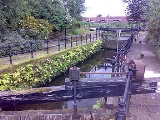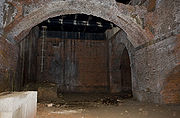
Manchester and Salford Junction Canal
Encyclopedia
The Manchester and Salford Junction Canal was a canal
in the city of Manchester
. It was originally built to provide a direct waterway between the Mersey and Irwell Navigation and the Rochdale Canal
. The canal opened in 1839 and was abandoned in 1922.
In 1799 the nearby Manchester Bolton & Bury Canal company (MB&B) proposed to connect their canal to the Rochdale canal with an aqueduct
across the M&IN. Due mainly to strong objections from the M&IN, who would have suffered a loss of trade, the link was not forthcoming. In 1805, John Nightingale was asked by the Mersey and Irwell Navigation Company to estimate the cost of a canal link between Manchester and Salford.
Nothing would happen until 1836, when John Gilbert was appointed as engineer. In 1838, just as the canal was being built, the Bridgewater Canal
Company were completing their Hulme Locks branch canal
. This provided an alternative route from the Rochdale Canal to the River Irwell, and cargoes from either direction could navigate onto the Irwell without the need to use the new Junction Canal.
 Construction of the new canal was funded in part by the proprietors of the MB&B canal. The canal was opened in 1839. In 1885 the Great Northern Warehouse
Construction of the new canal was funded in part by the proprietors of the MB&B canal. The canal was opened in 1839. In 1885 the Great Northern Warehouse
was built on top of the line of the canal and a dock was constructed to allow the interchange of goods. There were four large bays below the warehouse with two lift shafts to allow goods to be unloaded from the boats using the canal, and raised up to the warehouse for storage.
Company, removing the competitive incentive for keeping both canals open and the Junction Canal was abandoned in 1922. During the Second World War, sections of the canal were drained and converted for use as air-raid shelters.
s (1 km) between the River Irwell from southwest of Quay Street, to a branch of the Rochdale Canal southeast of Lower Mosley Street, mostly through a 499 yards (456 m) tunnel. The canal is now dry, and disused, although large parts remain underneath the city, particularly sections underneath the Great Northern Warehouse
and Granada Television
. The original western entrance is still visible from the River Irwell; the eastern entrance has been redeveloped into a small canal basin behind the Bridgewater Hall
.
The canal used four locks
and lifted water from the River Irwell with two pumping station
s.
Canal
Canals are man-made channels for water. There are two types of canal:#Waterways: navigable transportation canals used for carrying ships and boats shipping goods and conveying people, further subdivided into two kinds:...
in the city of Manchester
Manchester
Manchester is a city and metropolitan borough in Greater Manchester, England. According to the Office for National Statistics, the 2010 mid-year population estimate for Manchester was 498,800. Manchester lies within one of the UK's largest metropolitan areas, the metropolitan county of Greater...
. It was originally built to provide a direct waterway between the Mersey and Irwell Navigation and the Rochdale Canal
Rochdale Canal
The Rochdale Canal is a navigable "broad" canal in northern England, part of the connected system of the canals of Great Britain. The "Rochdale" in its name refers to the town of Rochdale, Greater Manchester, through which the canal passes....
. The canal opened in 1839 and was abandoned in 1922.
History
The lack of any direct canal link between the Mersey and Irwell Navigation (M&IN) and the Rochdale Canal meant that goods being transported using both waterways had to be offloaded onto carts and carried across the city, before being loaded back onto boats to continue their journey. This was costly and time-consuming, as well as adding to traffic congestion on the streets of Manchester.In 1799 the nearby Manchester Bolton & Bury Canal company (MB&B) proposed to connect their canal to the Rochdale canal with an aqueduct
Aqueduct
An aqueduct is a water supply or navigable channel constructed to convey water. In modern engineering, the term is used for any system of pipes, ditches, canals, tunnels, and other structures used for this purpose....
across the M&IN. Due mainly to strong objections from the M&IN, who would have suffered a loss of trade, the link was not forthcoming. In 1805, John Nightingale was asked by the Mersey and Irwell Navigation Company to estimate the cost of a canal link between Manchester and Salford.
Nothing would happen until 1836, when John Gilbert was appointed as engineer. In 1838, just as the canal was being built, the Bridgewater Canal
Bridgewater Canal
The Bridgewater Canal connects Runcorn, Manchester and Leigh, in North West England. It was commissioned by Francis Egerton, 3rd Duke of Bridgewater, to transport coal from his mines in Worsley to Manchester...
Company were completing their Hulme Locks branch canal
Hulme Locks Branch Canal
The Hulme Locks Branch Canal was a canal in the city of Manchester. It was 200m in length and was built to provide a direct waterway between the Mersey and Irwell Navigation and the Bridgewater Canal...
. This provided an alternative route from the Rochdale Canal to the River Irwell, and cargoes from either direction could navigate onto the Irwell without the need to use the new Junction Canal.

The Great Northern Warehouse
The Great Northern Warehouse is a former railway goods warehouse building of the Great Northern Railway, which has been redeveloped as a car park and leisure complex. The building is located at the junction of Deansgate and Peter Street in Manchester city centre, England...
was built on top of the line of the canal and a dock was constructed to allow the interchange of goods. There were four large bays below the warehouse with two lift shafts to allow goods to be unloaded from the boats using the canal, and raised up to the warehouse for storage.
Decline
The canal was constructed just as railways were becoming popular. In later years, both the Bridgewater and Rochdale canals came to be owned by the Manchester Ship CanalManchester Ship Canal
The Manchester Ship Canal is a river navigation 36 miles long in the North West of England. Starting at the Mersey Estuary near Liverpool, it generally follows the original routes of the rivers Mersey and Irwell through the historic counties of Cheshire and Lancashire. Several sets of locks lift...
Company, removing the competitive incentive for keeping both canals open and the Junction Canal was abandoned in 1922. During the Second World War, sections of the canal were drained and converted for use as air-raid shelters.
Route
The canal ran for 5 furlongFurlong
A furlong is a measure of distance in imperial units and U.S. customary units equal to one-eighth of a mile, equivalent to 220 yards, 660 feet, 40 rods, or 10 chains. The exact value of the furlong varies slightly among English-speaking countries....
s (1 km) between the River Irwell from southwest of Quay Street, to a branch of the Rochdale Canal southeast of Lower Mosley Street, mostly through a 499 yards (456 m) tunnel. The canal is now dry, and disused, although large parts remain underneath the city, particularly sections underneath the Great Northern Warehouse
The Great Northern Warehouse
The Great Northern Warehouse is a former railway goods warehouse building of the Great Northern Railway, which has been redeveloped as a car park and leisure complex. The building is located at the junction of Deansgate and Peter Street in Manchester city centre, England...
and Granada Television
Granada Television
Granada Television is the ITV contractor for North West England. Based in Manchester since its inception, it is the only surviving original ITA franchisee from 1954 and is ITV's most successful....
. The original western entrance is still visible from the River Irwell; the eastern entrance has been redeveloped into a small canal basin behind the Bridgewater Hall
Bridgewater Hall
The Bridgewater Hall is an international concert venue in Manchester city centre, England. It cost around £42 million to build and currently hosts over 250 performances a year....
.
The canal used four locks
Lock (water transport)
A lock is a device for raising and lowering boats between stretches of water of different levels on river and canal waterways. The distinguishing feature of a lock is a fixed chamber in which the water level can be varied; whereas in a caisson lock, a boat lift, or on a canal inclined plane, it is...
and lifted water from the River Irwell with two pumping station
Pumping station
Pumping stations are facilities including pumps and equipment for pumping fluids from one place to another. They are used for a variety of infrastructure systems, such as the supply of water to canals, the drainage of low-lying land, and the removal of sewage to processing sites.A pumping station...
s.
| Location | Coordinates |
|---|---|
| Lock 1 | 53.4789°N 2.25725°W |
| Lock 2 | 53.478734°N 2.256632°W |
| Slate Wharf | 53.478416°N 2.256148°W |
| Transhipment Dock | 53.476848°N 2.249349°W |
| Lock 3 | 53.476445°N 2.248293°W |
| Lock 4 | 53.476396°N 2.247946°W |
| Stop Lock | 53.475716°N 2.245764°W |
| Bridgewater Hall Basin | 53.475582°N 2.245167°W |
See also
- Canals of the United KingdomCanals of the United KingdomThe canals of the United Kingdom are a major part of the network of inland waterways in the United Kingdom. They have a colourful history, from use for irrigation and transport, through becoming the focus of the Industrial Revolution, to today's role for recreational boating...
- History of the British canal systemHistory of the British canal systemThe British canal system of water transport played a vital role in the United Kingdom's Industrial Revolution at a time when roads were only just emerging from the medieval mud and long trains of pack horses were the only means of "mass" transit by road of raw materials and finished products The...

